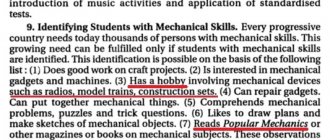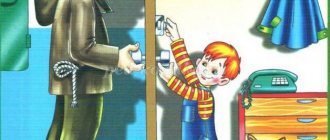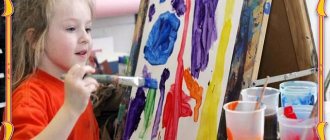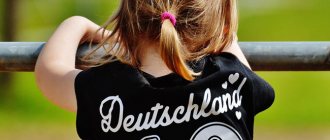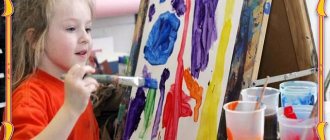Aesthetic education makes an important contribution to the implementation of all types of education, has a formative influence on the development of personality, and lays the foundations of morality. Knowledge about nature and society would also not be so complete if it had not passed through the prism of aesthetic perception.
Among the means of aesthetic education, three interdependent groups are distinguished:
- Environment. This includes the aesthetics of everyday life in a family, a preschool institution, the beauty of nature, harmonious relationships among members of groups where the child exists.
- Art, all its forms.
- Personal creative and artistic activity of children, not limited to one area.
The importance of teacher-parent interaction
The new educational philosophy, which asserts the primacy of parental responsibility over the responsibility of teachers in school and preschool institutions, cannot be called so new. The family has always determined the individual and his further life path. It’s just that at the time when the primacy of the public over the personal was proclaimed, they tried to forget about it. Now we have returned to the understanding that social institutions only support and continue the character, behavior patterns, and tastes established in the family.
note
The main task of parents and teachers in the educational process is interaction based on trusting relationships. Parents develop the child in the chosen direction, teachers deepen and correct the process in close cooperation with older family members.
The first social institution, a kindergarten, becomes a center that collaborates with other pedagogical and cultural institutions and involves parents in the educational process. barely emerging problems through the family, using a differentiated approach.
Means of forming the aesthetic culture of students in the work of the class teacher
The aesthetic experience of mankind, accumulated over millennia of its development, is rich and varied, presenting itself in the entirety of the material world, which man created in accordance with his ideas about the laws of beauty.
Over the centuries, ideas about the ideal of beauty have been formed, which found expression in its pure form, primarily in works of art and crafts. The formation of an individual’s aesthetic culture is carried out primarily on the basis of the perception of works of art (S.A. Anichkin, N.I. Kiyashchenko, N.L. Leizerov, B.T. Likhachev, G.S. Labkovskaya, N.M. Sokolnikova,
O. B. Gordienko, N. V. Kireeva, etc.), which are a direct reflection of the aesthetic perception of reality by a creative person and directly influence the viewer, reader, listener with their content.
Art is one of the most powerful pedagogical means of forming an individual’s aesthetic culture, which appears before us as a kind of bridge connecting people regardless of age, interests, language, or nationality. Art is a special world of culture, communication, relationships and human self-expression.
The emotional richness of art, its sensuality, symbolism and imagery are in harmony with the emotional world of man. From an early age, a child is able to express emotions, sincerely respond to the heartfelt and imaginative meanings of the artistic culture of his people, which is close and understandable to him from birth. Therefore, art is a necessary component in the subject system of any educational system.
An equally effective means of aesthetic education for schoolchildren is nature. Extensive experience in aesthetic education of children with the help of nature has been accumulated by K. D. Ushinsky, V. A. Sukhomlinsky and other famous teachers.
V.A. Sukhomlinsky argued that teaching a child to live in a world of beauty, “so that he cannot live without beauty, so that the beauty of the world creates beauty in him,” forms his professional credo. “The joy of work,” the teacher said, “is unthinkable without a sense of beauty.” Creating for everyone a science about how the beauty of the world should create beauty in man himself, V. A. Sukhomlinsky saw the highest educational task in the formation of people who not only love nature, but they are also able to decorate it for everyone’s happiness.
The work and organization of a child’s life are of particular importance for the formation of an individual’s aesthetic culture.
Work has always been the most important condition for the development of the human personality. During the work, a feeling of beauty arose. In addition to acquiring professional skills, he helped the younger generation acquire aesthetic views, tastes, traditions, aesthetic norms and standards accepted in society.
Family is the main factor in aesthetic education
The specific influence of the family team is a prerequisite for the comprehensive and timely development of the individual. The child’s horizons gradually expand, first experience is acquired, first work skills are mastered, the ability to organize leisure time is acquired, and a future family man is raised.
For full aesthetic development, a child must first develop an emotional sphere.
Aesthetic sensitivity is established already in those moments when the baby sees the mother’s face, reaches out to a bright toy, and dances to the sounds of rhythmic music. Accusing adult children of callousness and emotional unresponsiveness, parents forget that they once did not react to the child’s enthusiastic exclamations about a fluttering butterfly, did not stop to admire the flower, and did not pay attention to the life of the anthill.
The family lays the foundations of observation, which enriches the understanding of objects, their shape, color, differences and similarities.
Aesthetic sensitivity develops when parents attract the baby’s attention with a cloud in the sky, the color of leaves on a tree, or the festive decoration of city streets. Today, the child chooses a cup by color and pattern and tries not to break it. Tomorrow he will be selective towards many “adult” things and phenomena, will be able to justify his choice, give them an aesthetic assessment. Thoughtful organization of creative activities - what is available to the father and mother will become a solid foundation for the personality in the future.
Artistic and aesthetic development and education
Aesthetic development is the process and result of developing the ability to see and create the beauty of the surrounding world and art. M.N. Zubareva identifies the following stages of aesthetic development of preschool children.
At the first stage, a 3-4 year old child is emotionally aroused by the image of familiar objects that he recognized in the picture, but has not yet depicted. The motive for the evaluation is figurative or everyday in nature (he/she chose the card because “there is no such card at home yet,” “because there is a boat here, you can ride on it,” “because it’s an apple, it’s delicious”).
At the second stage, at the age of 5 years, the child begins not only to see, but also to recognize those elementary aesthetic qualities in a work of art that make it attractive to him. Children can receive basic aesthetic pleasure by appreciating a picture as a beautiful color, color combinations of depicted objects and phenomena, and less often - shape and compositional techniques.
At the third, higher stage, children aged 6-7 years rise to the ability to perceive more than is contained in the external signs of the depicted phenomenon. The child comprehends the internal features of an artistic image.
The main pedagogical conditions for the aesthetic development and transition of children from one stage to another are as follows:
- Organization of the child’s perception;
- Organization of material and cultural space. Availability of various educational objects and environments for contemplation;
- Professionalism in managing the aesthetic education of children;
- The child's interest in the activity. It is necessary to give the child the opportunity to express his own creative thoughts and feelings. These conditions make the process of aesthetic development purposeful and controllable and allow, in the words of L. S. Vygotsky, to “guide development.” In this case we are talking about aesthetic education.
The methodological foundations of aesthetic education are presented in Figure 23.
L.S. Vygotsky, B.M. Teplov, A.N. Leontyev, A.V. Zaporozhets, V.N. Shatskaya, E.A. Flerina, N.N. Sakulina, N.A. Vetlugina and others dealt with the problems of aesthetic education in home pedagogy.
From a modern point of view, aesthetic education is the organization of children’s life and activities, contributing to the development of the child’s aesthetic sense, the formation of ideas and knowledge about the beauty in life and art, aesthetic appreciation and aesthetic attitude towards everything that surrounds us.
The goal of aesthetic education is to develop the child’s personal readiness to perceive, master, and evaluate aesthetic objects in art or in reality; development of aesthetic consciousness, introduction to harmonious self-development; formation of creative skills and abilities in the field of artistic, spiritual and physical (bodily) culture.
Basic means and components of aesthetic education
In the general system of multidirectional development of individuality, aesthetic education identifies individual elements and makes them a means of aesthetic influence. Intellectual and speech activity is characterized by the beauty of the art of words. The beauty of work is emphasized by the height of goals, the process and results of work, and the harmonious relationships that arise in the process of work.
The moral and legal realization of a person originates in beautiful ideals and is consolidated through noble aspirations and established norms of behavior. Education of schoolchildren through the means of art passes through artistic images and harmony of sounds. Physical education and dancing deepen knowledge about the human body and give concepts about hygiene.
This is interesting
A variety of creative activities for preschoolers and primary schoolchildren develop imagination, instill work skills, and most positive moral qualities. The development in children of the ability to improvise in the process of creativity forms a critical view of everyday things and the results of human activity.
Aesthetics of everyday life
Everything that surrounds children from the first years has a great influence. A beautiful, comfortable interior, harmony of colors, and style of the room shape the child’s consciousness and are stored in memory. At home or in kindergarten, each item should have its own place. Educators need to pay attention to the purity and beauty that flowers and paintings give. Children's attempts to decorate the room on their own are welcome. You need to not only learn to see the beautiful things around you, but also to appreciate and preserve them.
Musical education in kindergarten
The design of a room for children must meet the following requirements:
- The situation is subject to considerations of expediency and practical benefit.
- Cleanliness, simplicity, and a harmonious combination of things and furnishings are maintained.
- Colors and light harmonize or create the contrast necessary to highlight and emphasize any objects.
- The interior components form a single ensemble.
Nature is a powerful means of aesthetic education
Having close contact with nature and its phenomena, children comprehend harmony. Nature itself creates beauty, following the example of which artists and composers create.
The teacher helps to see the beauty of a drop of dew or the colors of a sunset. The main thing is to find those words that will sink into the child’s soul. Here it is important to skillfully use examples from works of art. Excursions held in picturesque corners will be remembered for a long time and will make their contribution to the educational process.
Labor as a means of aesthetic education
The social life and work of parents and acquaintances is something that children constantly encounter. By paying attention to the work of builders, the children learn from them how to act in a coordinated manner. A story about the work of sailors, pilots or teachers fascinates and gives rise to a desire to imitate.
Through excursions and play, children accumulate sensory experience, compare, generalize, learn to appreciate the beauty of work, the nobility of human relationships, make them understand the importance of camaraderie, and show concern for loved ones.
Visual examples of how craftsmen use natural materials to produce clothing, housing, delicious food, create a more comfortable environment, and decorate everyday life help children understand the transformative power of labor.
The importance of folk art in the education of preschool children
Folk art is an important condition and means of aesthetic education . It combines oral folklore, musical creativity, and visual arts.
From the first years, the child is accompanied by folk tales and lullabies. Musical works deepen emotional responsiveness. Folk art helps you get acquainted with the traditions, peculiarities of life of your nation, and become familiar with the culture.
Important
Young preschool and school age is the most favorable for the perception of folk art. The power of influence on children will become much more effective if they take an active part in round dances, games, and singing songs.
Riddles help develop thinking and teach analysis. Dance instills flexibility and coordination. Fairy tales educate and introduce people to the historical past. Nursery rhymes, tongue twisters, sayings enrich children's speech and stimulate emotionality. The main thing is to take into account the age of the children, their ability to perceive a particular work. Artistic material becomes more complex at each subsequent age stage.
Education through art
The role of arts and crafts
Individual and group classes where folk crafts are studied lead children to an understanding of the way of life and the way of life of the people. Pupils get acquainted with crafts, traditional products, ornaments and patterns, composition.
To develop creative abilities, it is useful to create modeling and drawing clubs at school, work with appliqué, design, and master papier-mâché painting.
In addition to getting acquainted with decorative and applied arts, social and aesthetic problems are solved: children learn to perceive beauty and treat it with care. They develop mental processes that will be useful in further creative work and are important not only for general development, but also for moral education. Pride in one’s people and love for the Fatherland are formed.
Visual activities
The inclusion of younger children and schoolchildren in independent artistic activities is the rule of full-fledged aesthetic education. At home, in the kindergarten group, it is necessary to create special areas where children will have access to materials and equipment for drawing. In the process of working with crayons and pencils, children realize their creative inclinations, which in the future can develop into artistic creativity.
Adults need to stimulate children’s independent actions, guide them in the right direction, and give useful tips.
The specificity of drawing classes opens up wide opportunities for the development of students’ emotional and aesthetic attitude towards the world around them. By understanding proportionality, the proportionality of objects, and the richness of color shades, children learn to see real-life beauty, and they form beliefs that influence behavior.
Musical means of aesthetic education
Even simple songs that are accessible to the youngest are deeply artistic. Sounding during morning exercises, music energizes and activates. It is used in games, giving commonality to children's experiences.
The first music lessons awaken the ability to determine the character and mood of the transmitted image and evoke responses. More developed musicality is the ability to listen attentively and emotionally evaluate the most striking musical segments. A developed musical and auditory culture helps a child to appreciate a musical image in his own way and to imagine it in singing or dancing.
A variety of emotional experiences, awakened by music, cultivate an attitude towards beauty, give rise to good feelings, and a careful attitude towards the beauty in nature and all living things.
MAGAZINE Preschooler.RF
Conditions, means and role of the teacher in the aesthetic education of childrenAesthetic education is one of the areas of pedagogy, the main goal of which is to teach a person to understand and appreciate beauty. A.P. Chekhov said: “Everything in a person should be beautiful: face, clothes, soul, and thoughts . In order for a person to create beauty in himself and around him, he must first of all learn to hear, see, understand, and most importantly, feel beauty. Translated into Greek, feel and sensual will be the word aesthetics. Hence the concept of aesthetic education as the education of sensuality. Aesthetic education of preschoolers is a process through which the child develops the ability to notice the beauty of the environment, love art and be involved in it. The influence on the child’s personality begins from the first year of his life; it must be targeted and systematic.
The goal of aesthetic education is to teach a child to see and understand the beauty around him.
Cultivating a sense of beauty is not limited to artistic and musical perception. This is a whole system that includes the child’s attitude to social work and life, to everyday life and nature.
The role of aesthetic education in child development
From the first days of life, a child is attracted to bright shiny toys and objects, colorful colors and attractive elements. Satisfied interest gives them a feeling of joy and pleasure. The concept of “beautiful” is recognized by the child very early. Listening to fairy tales or songs, looking at pictures and toys, they get a lot of positive emotions and experiences. These unconscious impulses, in the process of aesthetic education and development of preschool children, gradually transform into a conscious perception of beauty. The task of adults is to form the foundations of harmonious taste, develop the artistic and creative abilities of preschool children, their aesthetic feelings and ideas.
Aesthetic education is an important aspect of the full development of a child, because it promotes:
- Development of the emotional and sensory sphere;
- The child’s sensory culture is formed (children listen to the sounds of the forest, birdsong, rustling leaves; examine the beauty and color of trees; inhale the aromas of flowers, meadows, fields);
- Aesthetic ideas about actions and behavior patterns are formed;
- Aesthetic education enhances: mental education (imagination, auditory and visual memory develops, knowledge about folk arts and music expands; physical education (music, artistic expression, colorful paraphernalia contribute to the formation of tempo, rhythm of movements, plasticity, positive attitude towards physical culture) ; moral education, because in the beauty of nature and art lies the greatest educational force, which forces the child to observe the rules of respect for nature and the environment.
The means of aesthetic education of children are objects and phenomena of the surrounding reality selected by the teacher and specially organized for the education of children. These include:
- Aesthetics of everyday life means teaching a child to see beauty in the ordinary (beautiful curtains, napkins, toys, furniture). If the environment is aesthetic, beautiful (not necessarily rich), if the child sees beautiful relationships between people, hears beautiful speech, there is reason to hope that from an early age he will accept an aesthetic environment as the norm. Three rules that make everyday aesthetics a means of aesthetic education: live in beauty, notice beauty, maintain and create beauty around you.
- Works of art. They are used in the design of everyday life, during training, and in independent activities. For this purpose, they select works of everyday and fairy-tale painting (portraits, still lifes, landscapes), graphics (prints, engravings, book illustrations), small forms of sculpture (faience, plaster, wood), works of folk applied art (ceramics, glass, folk decorative items, etc...)
- Nature. Growing up among nature, a child learns to see the harmony, beauty, and richness of colors of each season, and to reproduce his impressions in oral stories, drawings, etc. All this is accompanied by the teacher’s stories that nature is a powerful and perfect creator of beauty; painters, composers, and writers draw inspiration from it. 4.Special training. The formation of ideas about beauty, skills in artistic and creative activity, and the development of aesthetic assessments are facilitated by special training for preschoolers in kindergarten. To do this, I use various types of classes, artistic and didactic games, holidays, matinees, excursions, walks, watching performances, presentations, etc.
- Holidays. They are associated with children’s vivid aesthetic experiences, desires to test themselves in different genres of art, and performances in colorful costumes. Preparing for the holiday, children's participation in creating performances, and anticipation of the festive action form a special pre-holiday collective mood.
- Independent artistic activity of children. It is an important means of aesthetic education of preschool children. In the process of artistic activity, they realize their creative ideas, inclinations, which can subsequently develop into the ability for artistic creativity. To develop independent artistic activity, special centers are created with the necessary equipment and materials that children can use freely. The teacher takes care of the variety of children’s activities, the combination of different types of artistic activities: visual, artistic and speech, theatrical and playful, musical. 7. A museum, cinema, and cultural center can play a significant role in aesthetic education. Visiting cultural centers also forms the first skills of artistic and aesthetic perception in childhood. The basis of the process of aesthetic education is the activity of the teacher and the child, aimed at developing his abilities to perceive beauty, artistic values and productive activity. The personality of the teacher also plays an important role in the aesthetic education of preschoolers. The teacher himself must be an example of moral behavior and be a well-rounded personality, since the child relies on his own feelings and emotions. It is necessary to competently select the content of the proposed material and determine it in accordance with the age and individual capabilities of preschoolers. Also, it is necessary to introduce into joint activities special methodological actions and techniques that ensure active and meaningful assimilation of knowledge and skills. The teacher introduces to the beautiful, encourages empathy, emotional responsiveness to the beauty in the world around us.
The key role of a kindergarten is to create conditions for the formation of a harmoniously, intellectually developed personality.
- Creation of an aesthetic subject-development environment: beauty and cleanliness in the group, harmonious combination of colors of curtains, walls, bedspreads in the bedroom; aesthetic thoughtfulness of furniture and equipment.
- Saturation of groups with objects of art: paintings, panels, vases, objects of folk and applied arts.
- Presence of book, art, theater and music centers in the group.
- It is necessary to monitor the external appearance of the people around you: the teacher, junior teacher and other employees of the preschool institution (beautiful, neat, good manners of behavior and communication).
- It is necessary that the groups have corners of nature, on the street - a vegetable garden, flower beds, green spaces.
- It is necessary to hold holidays and entertainment for children and parents with music, poetry, skits, and dances.
In our group, conditions have been created for the aesthetic education of children. Created (slide) for a variety of artistic activities, in which children engage both under the guidance of teachers and on their own initiative. For creative activity, it is very important that the environment surrounding the child is beautiful, cozy, and comfortable at home. This liberates the child and encourages creativity. It is important not only to feel, but also to create something beautiful. Children are given the opportunity to draw, sculpt, and appliqué at any time, using different materials. The creativity center has a lot of step-by-step educational samples, visual aids, and stencils. We organize the introduction of children to decorative activities: (slide) we consider elements of decorative painting, silhouettes of folk toys, nesting dolls, thematic coloring books “Getting to Know Painting” , children love to play games such as “Learn the Painting” , “Find the Similarities and Differences of Folk Costumes” " , "What's superfluous" , etc. We got acquainted with the products of folk craftsmen, watched presentations on the creation of Russian and Vyatka nesting dolls. (slide)
We are trying to conduct more non-traditional art activities using different drawing techniques and materials (this is drawing with pokes, cotton swabs, drawing with fingers, (slide) scratching with stacks, drawing with salt, printing with a sponge, blowing a drawing from a “Blotography” , (we took part in the All-Russian competition "Blotography" . We use materials such as special stencils for glass, (slide) plaster figures, colored crayons, washable markers, wooden blanks. For modeling classes we use various waste materials, rainbow sand (slide), clay. The use of such techniques and methods develop children's imagination and creative imagination. We display the best works in a group on the "Beauty Shelf" . (slide) We teach children to use means of artistic expression (poems, proverbs, sayings, excerpts from works). Music plays an important role in the aesthetic education of children -theatrical activity. Music has a sound nature, a generalization of images, being “the art of feelings ,” as P.I. said. Chaikovsky. We try to make music sound not only in music classes, but also in everyday life, in children’s games, during exercises, and in other types of activities. The group has created a musical and theatrical center (slide), in which children enjoy playing musical instruments, (slide) participate in the dramatization of fairy tales, (slide) performances, and dramatizations. We use various types of theaters: finger theater, magnetic theater, bibabo toys, etc. d.
To enrich emotional and sensory perception, each group has conditions for introducing children to fiction. In the book center (slide) there are portraits of writers, necessary selections of literature to introduce children to them, their works, fairy tales, and folklore.
The leading place in the artistic and aesthetic development of children belongs to kindergarten. But the role of the family is also great. The result of such activities is the participation of students with their parents in competitions at the district and regional levels. Nikita Gorin took first place in the regional competition “Winter's Tale” with the craft “At the edge of the forest, winter lived in a hut . Only with the unity of the influence of the kindergarten and the family is it possible to fully implement the tasks of aesthetic education. Not every child will become a musician, artist, or writer, but every child can and should develop a love and interest in art, develop aesthetic taste, an ear for music, and basic drawing skills.
Thus, a properly organized system of work on the artistic and aesthetic education of children, the creation of conditions for aesthetic education, the organization of the educational process will create favorable conditions for the development of children’s artistic and aesthetic abilities, creative imagination and, as a result of aesthetic education, a spiritually rich , a comprehensively developed personality.
Dear teachers!
Let's cultivate in our children a sense of beauty and aesthetic perception, because this is so necessary in our time.
| Next > |
Continuity of aesthetic education
A complete solution to the problems of aesthetic education is only possible by combining the efforts of the kindergarten, school and family. A child will not necessarily become a musician or an outstanding artist, but everyone needs to awaken interest in art, aesthetic taste, love of music, and basic drawing skills.
Educators give advice to parents about what conditions need to be created at home for proper aesthetic education. Parents do not always attach due importance to the aesthetics of everyday life and choose the right tone of communication with each other and their children. The teacher gently helps students realize the need to read and listen to music.
Pupils at home should have everything they need to express themselves in creativity: albums with pencils and paints, educational games, books. Achieving continuity in educational issues between the child care institution and the family lays the foundation for the spiritual culture that modern youth should become the owner of.
The purpose and objectives of aesthetic education
Aesthetic education is the interaction of a student with a teacher and the educational environment, which includes all, without exception, aspects of mastering the world according to the laws of beauty. Traditionally, the main goal of aesthetic education is the development of aesthetic culture. The aesthetic culture of a person is an individual appropriation, which is expressed in her aesthetic tastes and preferences. The aesthetic culture of the individual is manifested in relation to nature, to other people, to work, to learning and to art. It is expressed in the ability to build your life according to the laws of beauty.
The aesthetic culture of the individual is closely related to the aesthetic culture of society. The aesthetic culture of society is a set of phenomena, social institutions, practices, works, behavior patterns and attitudes associated with the implementation and recording of the aesthetic experience of humanity in a certain cultural and historical period. Aesthetic culture is most fully embodied in the art of its time, but the space of aesthetic culture is much wider than art. Aesthetic culture should cover all spheres of public life.
The higher the aesthetic culture, the more accurately, organically and confidently a person navigates life’s problems and in solving any professional problems. A strong sense of aesthetics helps to validate solutions found in various areas of life. A harmonious, intuitively acceptable solution to a problem is most likely to be correct. Aircraft designers, for example, claim that ugly planes don’t fly. Engineers who accurately calculate the design of future towers or bridges usually ensure that their designs are considered works of art.
However, aesthetic pleasure for an aesthetically developed person is delivered not only by the result, but also by the process of activity itself. Thus, solving the most complex mathematical or chess problems gives mathematicians and chess players real aesthetic pleasure. They openly talk about the beauty of the formulas, the conclusions and the results obtained.
Philosophers always emphasize that the aesthetic is closely related to the ethical. The ability to see and understand beauty is one of the important criteria for the moral development of an individual. Highly moral, selfless actions give a person pleasure, real aesthetic pleasure.

